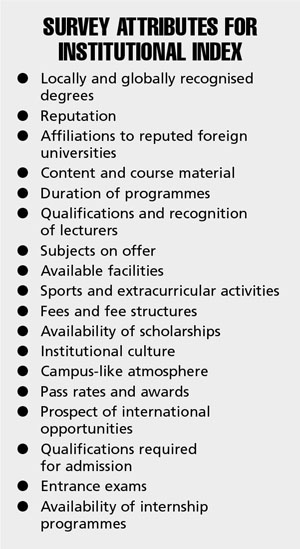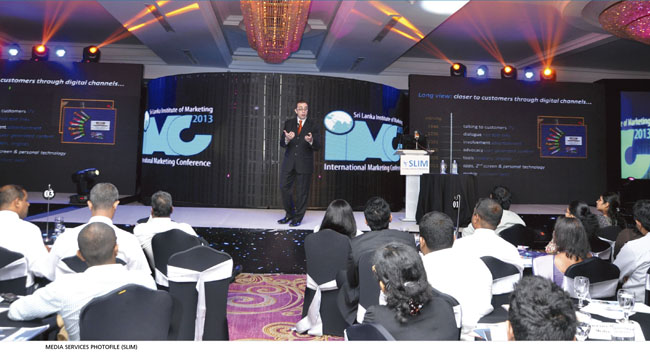
Joining the frenzy surrounding higher education at an early stage, the hunt for a learning utopia among parents and their offspring reaches intensity when secondary education is completed. Though the importance of education is not in question, selecting the appropriate educational institute is still an arduous task.
Following the completion of secondary school, students seek entry into state or private educational institutions that offer a learning experience in the name of ‘education.’
 DEFINITIONS Although ‘higher education’ generally means university studies, there’s no simple definition for it and some degree of confusion arises in attempting to describe it. Students who choose to advance their studies after completing college studies follow three broad categories: university education, professional education and vocational education.
DEFINITIONS Although ‘higher education’ generally means university studies, there’s no simple definition for it and some degree of confusion arises in attempting to describe it. Students who choose to advance their studies after completing college studies follow three broad categories: university education, professional education and vocational education.
Selecting a suitable institute is not an easy task, as ‘educational institutes’ continue to mushroom in every nook and corner, and the print media is laden with their advertisements. This is why a thorough assessment and evaluation is a ‘must do’ before students make a final decision, although the quality of educational services is often intangible and difficult to measure. Identifying the determinants of selecting a particular educational institute and measuring its relative importance varies from one student to the other.
THE SURVEY The main objective of the research carried out by TNS Lanka, for LMD, was to assess educational institutes in this country through the eyes of potential students and their parents. Among the assessed institutes, there are providers of university, professional and vocational education. The research was carried out via a structured questionnaire by TNS covering the city of Colombo and its suburbs, with a sample size of 650 prospective students and 200 parents.
Survey participants first selected their preferred subject stream, thereafter rating the importance of 18 attributes that are usually considered when selecting an educational institute (see accompanying box). The parameters that came into play in arriving at an index for each institution were the ‘awareness percentage’ of each institute among the target audience, their preferences and institutional performance.
But the importance of the 18 attributes can be perceived differently by students. For example, fee structures, the availability of scholarships and durations of degree programmes may be of utmost importance to one student, whereas another will focus more on the calibre of lecturers, foreign affiliations and global reputation.
Although all these attributes should be important in an ideal world, student competence, financial capabilities and the availability of quality institutions come into play when selecting an educational institute.
STATE SECTOR Despite the fact that free education plays a key role in Sri Lanka, state universities don’t have the capacity to accommodate all the students who deserve a university education. The reality is that many students enrol themselves at private educational institutions to fulfil their higher education aspirations. Those who cannot or do not enter state universities also opt to pursue their higher studies overseas, which results in a substantial outflow of foreign exchange and also obliquely encourages the brain drain.
In some instances, parents are unwilling to send their children to state universities and seek private higher education and overseas educational opportunities with a growing sense of urgency. Even some students who are qualified for admission are reluctant to enter state universities. Among the chief concerns are prolonged university closures, exams not being held as scheduled, ragging and issues pertaining to student intakes.
For example, the intake from the GCE A-Level examination in 2011 was not admitted in 2012 due to a pending court case on issues relating to the methodology adopted to calculate the Z-Score. However, the Government’s vision for higher education lists the eradication of ragging, which suggests that this perennial issue has at least made its way to the relevant authorities.

According to the Department of Education, out of the 196,954 students who sat the Advanced Level exam last year, 124,377 qualified for university entrance. Although this is around 63 percent of the students who sat the exam, it is less than 20 percent of those who gain university admission. On top of that, the actual graduate output is also much less than the enrolled student numbers.
BUDGET NEWS In the capital allocation of government grants to higher educational institutions this year, funds were allocated to develop multiple areas. Among them are rehabilitation and the improvement of assets, acquisition of fixed assets, knowledge enhancement and institutional development to enhance quality, development of student skills and strengthening research. It is also stated that Rs. 2.85 million is to be allocated towards the advancement of six universities to match international standards.
Although it is encouraging that funds are being allocated to improve higher education in this country, simply investing more in the sector without implementing the necessary reforms is unlikely to achieve the envisioned changes. The challenge for the education sector is one of improving quality, and funds should be channelled towards improving the education process and its outcomes.
Budget 2013 addressed the need to ensure that avenues are created for 10 percent of children entering schools each year to take on university studies, and 40 percent to enter vocational and technical education. The budget also allocated 1.6 billion rupees to set up 20 technical colleges attached to vocational technical university colleges that will accommodate over 50,000 A-Level students. But if affordability and quality standards aren’t met, this will continue to be a pipe dream.
ENGLISH AND IT Sri Lanka has a literacy rate of around 92 percent. However, this alone will no longer suffice in the modern world. English and IT are becoming more and more important in the 21st-century world of business, but many undergraduates leave a lot to be desired when it comes to English language skills. Both the public and private sectors acknowledge the importance of language, as finding suitable employment can become a mere dream if graduates aren’t competent in it.

Minister of Higher Education S. B. Dissanayake says that measures have been taken to provide the necessary facilities to follow university courses in the English medium, with the intention of modernising higher education to suit the employment market of this day and age. Meeting infrastructure requirements alone is a cumbersome task, apart from the need to change students’ mindsets – to accept the importance of being proficient in English and let go of their comfort zones.
In addition to arts, science, mathematics and commerce, technology has also been added to the Advanced Level curriculum with effect from 15 July in 242 schools across the island. This is a positive step towards acknowledging the importance of IT skills. Unless the younger generations are properly educated and trained in IT, Sri Lanka will continue to face the prospect of a digital divide.
HETC PROJECT Initiated in 2010, the Higher Education for the Twenty-first Century (HETC) Project for Sri Lanka by the World Bank aims to institutionalise norms in the higher education sector as its first component. This endeavour seeks to develop the institutional foundation of the higher education sector through the establishment of a qualification framework – one that covers higher education and training – and the development of a quality assurance system for the higher education sector as a whole.
CONCLUSIONS According to the Secretary of the Ministry of Higher Education Dr Sunil Nawaratne, some of the key themes of Sri Lanka’s Higher Education Strategy involve accepting responsibility for our graduates, building world-class universities, producing globally employable graduates, and improving the effectiveness and efficiency of the higher education system.
So yes, we have a long journey ahead, given the present state of affairs in the education sector.
Regularising non-state tertiary educational institutes is an imperative. Not only will this do justice to state university students, but also private educational institutes who are genuinely interested in meeting global education standards.
Education is a powerful tool to change oneself, and the world with it – and if Sri Lanka’s knowledge hub aspirations are to be met by year 2020, expanding educational pathways is the need of the hour. Sri Lanka should perhaps consider public-private partnership models for tertiary, professional and vocational education.
If Sri Lanka’s education sector is governed by appositely reformed state regulations and administered by unambiguous standards, maintaining a quality system to cater to student needs can become a reality. And this in turn will draw the vision of creating a knowledge hub ever so closer to reality.





What is the position of the Colombo International Nautical and Engineering Collage (CINEC)? Did you consider about CINEC or not?
Dear Sir,
Why don’t you all go around the country and do a survey such as this. If you are doing a survey about education institutions it should be around the country. Just taking a group of people in a centralised place is not enough to make some points and have an institution top ranked. It’s like taking one side of the education of Sri Lanka and promoting some organisations based on exterior. Don’t be favourable towards one central location and to some companies. There is more than that to think about when doing survey and publishing it. Please consider this matter also in your future surveys.
Thank you!